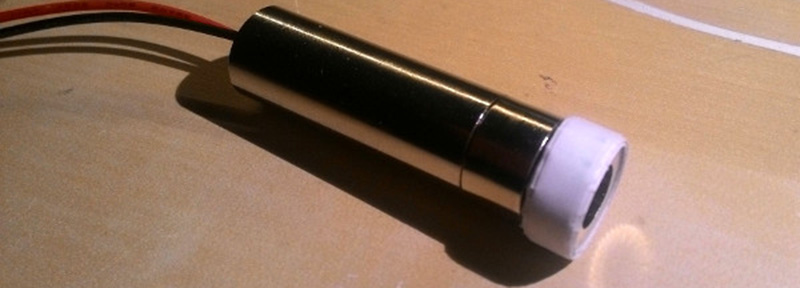Small and powerful laser diodes are getting cheaper and cheaper, and there are a few commercial products that give anyone the ability to cut paper and vinyl with a computer-controlled cutting machine. What happens when you combine the two? The beginnings of a hacked together laser engraver.
For this build, [Peter] is using a Silhouette Portrait, a desktop CNC cutting machine that’s usually used for vinyl decals and intricately cut paper crafts. This machine isn’t limited to mere decorative crafts – it’s been used for cutting PCB stencils and other pseudo-industrial tasks.
Because the Silhouette Portrait has an interface that allows just about any CAM software to control it, the only thing [Peter] needed to make for his experiments in laser engraving was a mount to hold the laser diode. Luckily, the laser had a similar form factor to the cutting blades for the machine, and a bit of tape held everything together.
Focusing the laser was done by unscrewing the lens, and with a bit of trial and error, [Peter] was able to make a few marks in the material of his choice. This isn’t a laser cutter, but with a little more work it will make a fantastic laser engraver.
















This is very interesting! I have a vinyl cutter and I hadn’t thought about doing this. The thickness of materials is a bit limited though.
Use a 20-50W LED module off Ebay (originally used for laser welding). Mount it 1metre over the printer and use an armoured fiberoptoic light guide (usual 1m long) to hang down and mount on the moving carriage.
Then you get a high powered laser with minimal mass transit problems. Its how mine works.
Lol.
How do you shroud it?
LEDs are not lasers…the photons are bouncing around like the hyperactive little bastards that they are, even trying to guide it with fiber they’re still bouncing everywhere. With a laser they’re emitted mostly parallel to each other.
It’s sort of like female vs male urination, if you want a meaty example.
I think he meant to say laser module, but who knows. Heck, a 50W LED might be able to cut stuff if you got it down to a fine enough point.
A 50W eBay laser is hardly a module, it’s more like a glass tube about 800mm (say 3 foot) long.
He is probably using a Coherent FAP module. I have a couple of these in the 50W flavor as well as 40 and 32 watt.
So the bottom line is that there is NO 50W laser LED module on ebay, that can be used for cutting !
I did find some 60w 808nm laser modules, but not on ebay.
https://www.youtube.com/watch?v=EbqJnS1AgPI&x-yt-cl=85114404&x-yt-ts=1422579428
I became dad just recently and i can only assure you that female peeing is also very targeted/focused! So this is not a very appropriate comparison.
I think that when he made that meaty comparison the targeted pee was the female
Trouble is that those are
1) invisible (focusing them is fun)
2) not meant to be used directly (output beam is a line, not a dot, also more focusing fun)
3) are meant to pump an actual solid-state laser, either fiber or traditional
A diode-pumped solid state laser (that still works) will run for several thousand $$$, not really a hobbyist choice. Even with DIYing it from ebay junk, you’re still looking at at least a thousand $$$, and that’s only the laser itself.
Burned his first laser … that’s what happens when you play with stuff without learning the basics. Ohms law is not enough for operating a laser LED.
i stopped reading when i saw the 12V supply feeding the laser through a resistor
Also, please don’t cut vinyl with a laser. It decomposes into chlorine gas and other rather nasty things and tends to catch fire and melt as well.
Never mind all that, it rusts your gear pretty quickly too.
Hey neon22,
I can only find white LED 50 modules on ebay.com.
Do you have a link for a 50W module that can be used as a laser cutter ??
Thanks
hah — I did that very thing back in August. Interestingly, it’s pretty easy to tap directly into the circuit that moves the pen up and down, which is apt to be more elegant than the improvised switch. You can disconnect it from the solenoid motor, and put a dummy resistor across the terminals — then it acts like a signal that is “high” until it gets pulled down. Or you could use an opto-isolator.
In the video below, I am using the solenoid driver directly with a ballasting resistor to light up the laser, but the solenoid drive circuit does not really put out enough current to make the laser light up as brightly as it ought to.
https://dl.dropboxusercontent.com/u/20883041/VID_20140810_191357.mp4
My evil intent was to use the laser to expose photosensitive film and or to convert graphene oxide to graphene (why use a laser-scribe — it’s slow and the geometry is restrictive).
I had a hard time getting a lens with a short enough focal length and then life intervened and I lost interest ..
http://youtu.be/VSb78xt0mDs